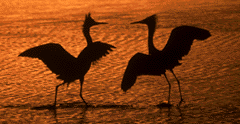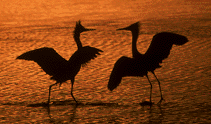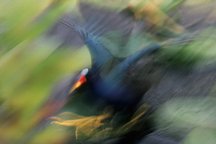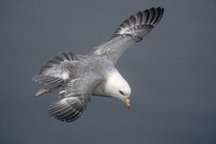 |
 |
||
Arthur Morris / Birds as Art
|
Home
|
General Bird Photography
Frequently Asked Questions
[ Back to Question List ]
What do you think of the Canon EF 300 mm F/4L IS lens?Almost a year ago, I bought myself a new toy, the Canon EF 300mm f/4.0L IS lens. The "IS" stands for image stabilized. As you look through the viewfinder and move the lens slowly, you'll note that the technology "dampens" subject movement. Canon's first IS lens, the 75- 300mm IS zoom, was an excellent travel lens, but was not razor sharp when shot wide open. And even though it was an autofocus lens, it was simply no good for photographing moving subjects. As you panned from left to right with a flying bird, the IS technology, in an attempt to stabilize the image, moved the bird left in the frame. The new 300mm IS lens is, however, a vast improvement in many ways. This "L" series lens is professionally sharp, even at wide open apertures. When handholding this lens and shooting static subjects, most photographers can produce sharp images with shutter speeds as slow as 1/90 or 1/60 of a second range. (Experienced shooters will be able to make sharp images at even slower shutter speeds.) With static subjects, choose the "IS 1" setting, which stabilizes the image along both the horizontal and vertical axes. Nature photographers wishing to photograph running rhinos or flying falcons will choose the "IS 2" setting; the image will be stabilized in one direction only, perpendicular to the movement of the lens. Now, as you swing the lens from left to right, the subject is stabilized only along the vertical axis; the subject will not be dragged backwards through the frame. The 300 IS focuses inside of five feet making head or eyeball shots of tame birds like gulls or fishing-pier pelicans (without having to mount an extension tube) a snap. With one or two extension tubes, it makes a wonderful macro lens (that offers lots of working distance) for subjects the size of small frogs or large flowers or insects. At Point Pelee National Park in Ontario, I used the 300 IS lens with the 1.4X TC and a 25mm extension tube to make head and shoulders portraits of the tiny, tame Barn Swallows nesting on the tower at Marsh Boardwalk. And by choosing the "IS 1" setting, you can--on sunny days--stop down to f/16 or even f/22 (with 100 speed film) for added depth of field; when that Snowy Egret looks right down the lens barrel, you'll be able to make an image that is sharp from the bird's eyes to the tip of its bill. The EF 300mm f/4 IS lens is perfect for those who photograph nature from any type of water craft, be it canoe, kayak, poke boat, or ocean liner. Making sharp images with the IS technology from a rocking boat is child's play. And the lens is superb in locations where the birds and other wild creatures are tame. On a recent visit to the Galapagos Islands, my good friend (and long-time Nikon shooter) Tom Vezo, brought his Canon 300 IS along and used it "more than 80% of the time with great success." Remember that handheld 300 and 400mm lenses are ideal for photographing birds in flight or in action. Using a lens in this class to photograph wildlife is far easier than using any tripod-mounted telephoto lens. Intermediate telephotos are less cumbersome to position and simply getting the lens on the subject is faster and easier. Similarly, it is easier to pan with the subject and keep the active AF sensor(s) on the subject with handheld outfits. And even when shooting static subjects with the 300 IS, you reap the same benefits: speed, maneuverability, and ease of use. I have quickly fallen in love with Canon's 300 f/4L IS lens, which I've affectionately dubbed "Toy Lens II." I absolutely love the close focus and have been experimenting with photographing moving birds at slow shutter speeds with the "IS 2" setting. Early results with these intentional blurs have been encouraging. I use Velvia rated at ISO 50 (I normally push nearly every roll of film that I shoot) so that I can select shutter speeds in the 1/15 to 1/30 second range. (In sunny conditions with 100 speed film, you would not be able to use such slow shutter speeds; you'd need to set an aperture smaller than f/32.) Now, on most sunny days, I carry the 300 IS lens with an A2 body over my left shoulder, the 400 f/5.6 outfit on my right shoulder, and the tripod-mounted 600mm f/4. The 28-135mm IS zoom lens is stowed in one of the large pockets of my Xtrahand vest. (On cloudy days, I do not take the 400 f/5.6, which I use almost exclusively for flight shooting on blue sky days.) [ Back to Question List ]
[ Birds As Art Home ]
|


